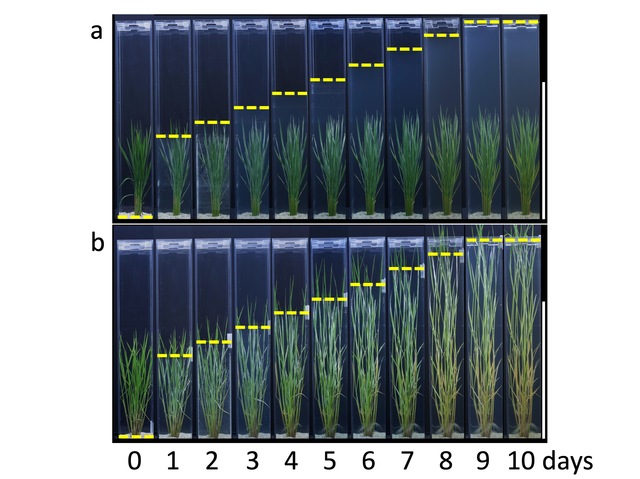Rice stems lengthen when a newly identified gene activates during flooding. Another gene suppresses lengthening in shorter varieties. The insight could help plant breeders.
Scientists at Nagoya University and colleagues in Japan have identified two antagonistic genes involved in rice plant stem growth. Their findings, published in the journal Nature, could lead to new ways for genetically modifying rice crops.
Longer, deepwater rice crops are planted in South Asia and West Africa to survive floods. Shorter paddy rice varieties are widely cultivated worldwide because they are easier to harvest.
A key driver of plant growth is a hormone called gibberellic acid. It activates cell division in the stem tissue, causing the stem to lengthen. Breeders know they can control plant height by stimulating or inhibiting gibberellic acid activity. However, exactly how this works has been unclear.
Bioscientist Motoyuki Ashikari has been studying the growth and evolution of rice for years. He and a team of researchers conducted genetic studies and identified two genes that are involved in regulating rice plant growth.
"We showed that gibberellic acid is necessary, but not enough, for stem elongation," says Ashikari.
Interestingly, the two genes, called ACCELERATOR OF INTERNODE ELONGATION 1 (ACE1) and DECELERATOR OF INTERNODE ELONGATION 1 (DEC1), counteract each other as part of the regulation process.
In the presence of gibberellic acid, ACE1 stimulates cell division and elongation of the stem's 'internode' sections in deepwater rice. The shorter paddy rice variety did not have a functional ACE1 gene, but it did have a homologous ACE1-like gene that was switched on to activate stem elongation at a different point of plant development.
DEC1 was found in both the deepwater and paddy rice varieties. Its expression was reduced when deepwater rice plants were placed in deep water or treated with gibberellic acid. However, DEC1 continued to be expressed in paddy rice, even under the same conditions, suggesting this gene helps to suppress stem growth.
 A short paddy rice variety (above) and long deepwater variety (below) were placed in rising levels of deep water. ACE1 was specifically triggered in the deepwater variety, stimulating elongation above water level. (Credit: Motoyuki Ashikari)
A short paddy rice variety (above) and long deepwater variety (below) were placed in rising levels of deep water. ACE1 was specifically triggered in the deepwater variety, stimulating elongation above water level. (Credit: Motoyuki Ashikari)
"We also found that ACE1 and DEC1 are conserved and functional in other plant species, like barley and other grasses, so our investigations improve understanding of the regulation of stem elongation in members of the Gramineae family that may have similar stem elongation mechanisms," says Ashikari.
The team next aims to understand stem elongation at the molecular level by identifying factors that are associated with ACE1 and DEC1 expression.
The research paper, "Antagonistic regulation of the gibberellic acid response during stem growth in rice," was published in Nature on July 16, 2020, at DOI: 10.1038/s41586-020-2501-8.
Authors: Keisuke Nagai, Yoshinao Mori, Shin Ishikawa, Tomoyuki Furuta, Rico Gamuyao, Yoko Niimi, Tokunori Hobo, Moyuri Fukuda, Mikiko Kojima, Yumiko Takebayashi, Atsushi Fukushima, Yasuyo Himuro, Masatomo Kobayashi, Wataru Ackley, Hiroshi Hisano, Kazuhiro Sato, Aya Yoshida, Jianzhong Wu, Hitoshi Sakakibara, Yutaka Sato, Hiroyuki Tsuji, Takashi Akagi & Motoyuki Ashikari
Contact:
Motoyuki Ashikari (Professor)
Bioscience and Biotechnology Center, Nagoya University
Email: ashi@agr.nagoya-u.ac.jp

